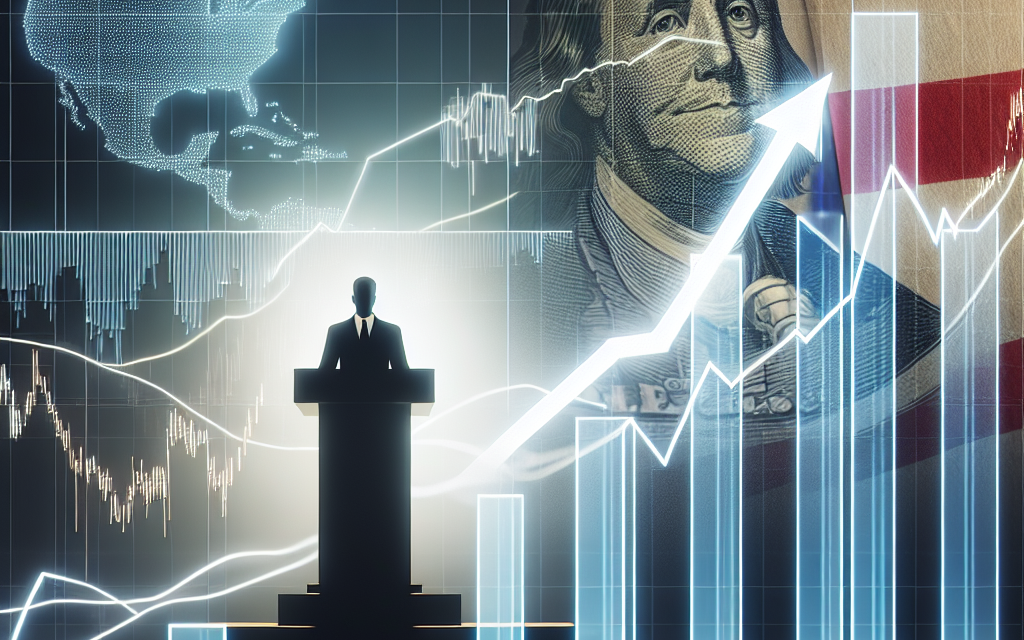“Optimism Soars: Markets Rally with Stocks and Dollar on the Rise Before Key Data and Powell’s Address”
Introduction
Markets experienced a notable rally as both stocks and the U.S. dollar climbed in anticipation of upcoming economic data releases and a highly anticipated speech by Federal Reserve Chair Jerome Powell. Investors are closely monitoring these developments for insights into the future trajectory of monetary policy and economic conditions. The positive momentum in the markets reflects optimism about potential signals from Powell regarding interest rates and inflation, as well as expectations for the forthcoming economic indicators. This rally underscores the market’s sensitivity to policy cues and economic data, highlighting the intricate balance between investor sentiment and macroeconomic factors.
Impact Of Powell’s Speech On Global Markets
As global markets brace for the much-anticipated speech by Federal Reserve Chair Jerome Powell, investors are keenly observing the potential impact on both stocks and the dollar. Historically, Powell’s speeches have been pivotal in shaping market expectations, particularly concerning monetary policy and interest rate trajectories. This time is no different, as markets rally in anticipation, with stocks and the dollar showing notable gains. The anticipation surrounding Powell’s address is not merely speculative; it is grounded in the broader context of economic indicators and the Federal Reserve’s policy direction.
In recent weeks, economic data has painted a mixed picture of the U.S. economy. On one hand, inflationary pressures appear to be easing, providing some relief to consumers and policymakers alike. On the other hand, concerns about economic growth persist, with some sectors showing signs of slowing down. Against this backdrop, Powell’s speech is expected to offer insights into the Federal Reserve’s assessment of the economy and its future policy stance. Investors are particularly interested in any hints regarding interest rate adjustments, as these have direct implications for both equity markets and currency valuations.
The rally in stocks can be attributed to investor optimism that Powell might signal a more dovish approach, potentially indicating a pause or slowdown in rate hikes. Such a stance would be welcomed by equity markets, as lower interest rates generally reduce borrowing costs for companies and can lead to higher valuations. Moreover, a dovish tone could also alleviate some of the pressure on emerging markets, which have been grappling with capital outflows and currency depreciation due to the strong dollar.
Simultaneously, the dollar’s climb ahead of Powell’s speech reflects a complex interplay of factors. While a dovish signal might typically weaken the dollar, the current rally suggests that investors are hedging their bets, possibly anticipating that Powell will maintain a balanced approach. The dollar’s strength can also be attributed to its safe-haven status, as geopolitical uncertainties and global economic challenges persist. Furthermore, the dollar’s rise is supported by robust U.S. economic fundamentals, which continue to attract foreign investment.
As markets await Powell’s remarks, the global implications are significant. A shift in U.S. monetary policy can have ripple effects across the world, influencing capital flows, trade balances, and economic growth in other countries. For instance, a stronger dollar can exacerbate debt burdens for countries with dollar-denominated liabilities, while also impacting export competitiveness. Conversely, a more accommodative U.S. policy could provide relief to these economies, potentially stabilizing global markets.
In conclusion, the anticipation surrounding Jerome Powell’s speech underscores the interconnectedness of global financial markets and the pivotal role of central bank communications. As investors navigate the complexities of economic data and policy signals, the outcomes of Powell’s address will likely set the tone for market movements in the coming weeks. Whether the rally in stocks and the dollar will sustain depends largely on the clarity and direction of Powell’s message, as well as the subsequent interpretation by market participants. As such, the global financial community remains attentive, ready to adjust strategies in response to the evolving economic landscape.
Analyzing The Dollar’s Climb Amid Market Rally
In recent weeks, financial markets have experienced a notable rally, with both stocks and the U.S. dollar showing significant upward momentum. This surge comes as investors eagerly anticipate upcoming economic data releases and a pivotal speech by Federal Reserve Chair Jerome Powell. The dollar’s climb, in particular, has garnered attention, as it plays a crucial role in shaping global economic dynamics. Understanding the factors behind this ascent and its implications is essential for comprehending the broader market rally.
The dollar’s strength can be attributed to several interrelated factors. Firstly, the anticipation of key economic data, such as employment figures and inflation rates, has heightened market expectations. Investors are keenly aware that these indicators will provide critical insights into the health of the U.S. economy and the potential trajectory of monetary policy. A robust economic outlook often bolsters the dollar, as it suggests a higher likelihood of interest rate hikes by the Federal Reserve. Consequently, the prospect of tighter monetary policy tends to attract foreign investment, driving up demand for the dollar.
Moreover, the dollar’s rise is closely linked to the performance of U.S. equities. As stock markets rally, international investors often seek to capitalize on the gains by purchasing U.S. assets, which necessitates the acquisition of dollars. This increased demand for the currency further contributes to its appreciation. Additionally, the dollar’s status as a safe-haven asset cannot be overlooked. In times of global uncertainty, investors frequently flock to the dollar as a secure store of value, reinforcing its upward trajectory.
Transitioning to the broader market context, the rally in stocks has been fueled by a combination of factors, including strong corporate earnings and optimism surrounding economic recovery. Companies across various sectors have reported better-than-expected earnings, instilling confidence in investors. This positive sentiment is further amplified by the gradual easing of supply chain disruptions and the ongoing rollout of vaccination programs, which have bolstered economic activity.
However, it is important to consider the potential implications of the dollar’s climb on the global economy. A stronger dollar can have mixed effects on international trade and emerging markets. On one hand, it can make U.S. exports more expensive, potentially dampening demand from foreign buyers. On the other hand, it can benefit countries that rely on dollar-denominated debt, as their repayment burden decreases in local currency terms. Thus, the dollar’s appreciation presents both challenges and opportunities for different economies.
As investors await Jerome Powell’s upcoming speech, they are keen to glean insights into the Federal Reserve’s policy stance. Powell’s remarks will be closely scrutinized for any indications of future interest rate adjustments or changes in the central bank’s approach to inflation. His speech has the potential to influence market sentiment significantly, as it will provide guidance on the Fed’s response to evolving economic conditions.
In conclusion, the recent rally in markets, characterized by the simultaneous rise of stocks and the dollar, reflects a complex interplay of economic indicators, investor sentiment, and monetary policy expectations. The dollar’s climb, driven by anticipation of economic data and its safe-haven appeal, underscores its pivotal role in global financial markets. As stakeholders await further developments, including Powell’s speech, the interplay between these factors will continue to shape the trajectory of both the dollar and broader market trends.
Key Data Points Influencing Stock Market Trends
As financial markets continue to navigate the complexities of a global economy in flux, investors are keenly focused on key data points that influence stock market trends. Recently, markets have rallied, with both stocks and the dollar climbing, as anticipation builds around upcoming economic data releases and a pivotal speech by Federal Reserve Chair Jerome Powell. Understanding the factors driving these movements is essential for investors seeking to make informed decisions in an ever-evolving landscape.
One of the primary data points influencing market trends is the release of employment figures. The labor market serves as a critical indicator of economic health, and fluctuations in employment data can significantly impact investor sentiment. A robust jobs report often signals economic strength, encouraging investment in equities as businesses are likely to experience growth. Conversely, weaker employment numbers may lead to concerns about economic slowdown, prompting a shift towards safer assets. As such, the upcoming employment data release is eagerly awaited by market participants, who are poised to adjust their strategies based on the insights it provides.
In addition to employment figures, inflation data plays a crucial role in shaping market dynamics. Inflation affects purchasing power and can influence central bank policy decisions, which in turn impact interest rates and borrowing costs. Investors closely monitor inflation trends to gauge the potential for monetary policy adjustments. A higher-than-expected inflation rate might prompt the Federal Reserve to consider tightening monetary policy, which could lead to increased interest rates and a stronger dollar. This scenario often results in a mixed response from the stock market, as higher borrowing costs can dampen corporate profits, while a stronger dollar can benefit companies with significant international exposure.
Moreover, consumer confidence indices are another vital data point that investors scrutinize. These indices provide insights into consumer sentiment and spending behavior, which are key drivers of economic activity. A rise in consumer confidence typically suggests that individuals are more willing to spend, potentially boosting corporate revenues and stock prices. On the other hand, a decline in confidence may signal caution among consumers, leading to reduced spending and potential headwinds for businesses. As such, the forthcoming consumer confidence report is likely to be a focal point for market participants.
In the midst of these data releases, all eyes are on Federal Reserve Chair Jerome Powell’s upcoming speech. Powell’s remarks are anticipated to provide clarity on the central bank’s outlook and policy direction, particularly in light of recent economic developments. Investors will be listening intently for any indications of changes in monetary policy, as these could have far-reaching implications for financial markets. A dovish tone from Powell might reassure investors and support further stock market gains, while a more hawkish stance could lead to increased volatility.
In conclusion, as markets rally with stocks and the dollar on the rise, the interplay of key data points such as employment figures, inflation data, and consumer confidence indices remains at the forefront of investor considerations. Coupled with the insights expected from Jerome Powell’s speech, these elements collectively shape the trajectory of stock market trends. By staying attuned to these indicators, investors can better navigate the complexities of the financial landscape and make informed decisions in pursuit of their investment objectives.
Investor Sentiment: How Markets React To Economic Data

Investor sentiment plays a crucial role in shaping market dynamics, often swaying the direction of stocks and currencies in anticipation of economic data releases and influential speeches. Recently, markets have experienced a notable rally, with both stocks and the dollar climbing as investors eagerly await upcoming economic data and a speech by Federal Reserve Chair Jerome Powell. This upward momentum reflects a complex interplay of optimism, caution, and strategic positioning by market participants.
The anticipation of economic data releases often serves as a catalyst for market movements. Investors meticulously analyze these data points to gauge the health of the economy and to adjust their portfolios accordingly. In the current scenario, the market’s focus is on key indicators such as employment figures, inflation rates, and consumer spending. These metrics provide valuable insights into the economic landscape, influencing investor decisions and, consequently, market trends. As investors brace for these data releases, the prevailing sentiment is one of cautious optimism, with many hoping for signs of economic resilience that could justify the recent rally.
In tandem with the anticipation of economic data, the market is also keenly attuned to the forthcoming speech by Federal Reserve Chair Jerome Powell. Powell’s remarks are highly anticipated as they often provide critical insights into the Federal Reserve’s monetary policy stance. Investors are particularly interested in any indications of future interest rate adjustments, as these have significant implications for both equity and currency markets. A dovish tone from Powell, suggesting a more accommodative monetary policy, could further bolster market confidence, while a hawkish stance might temper the current rally.
The recent climb in the dollar is another facet of the market’s response to these anticipated events. A stronger dollar often reflects investor confidence in the U.S. economy, as well as expectations of higher interest rates. This currency appreciation can have a ripple effect across global markets, influencing trade balances and impacting multinational corporations. As the dollar strengthens, it can also affect commodity prices, given that many are priced in dollars, thereby adding another layer of complexity to market dynamics.
Moreover, the rally in stocks is indicative of a broader risk-on sentiment among investors. This shift towards equities suggests a growing confidence in the market’s ability to weather potential economic headwinds. However, it is essential to recognize that this optimism is tempered by underlying uncertainties. Geopolitical tensions, supply chain disruptions, and the lingering effects of the pandemic continue to pose risks that could swiftly alter market trajectories.
In conclusion, the current rally in stocks and the dollar underscores the intricate relationship between investor sentiment, economic data, and central bank communications. As markets navigate this landscape, the interplay of optimism and caution will likely continue to drive volatility. Investors remain vigilant, balancing the potential for economic growth against the backdrop of persistent uncertainties. As such, the forthcoming economic data and Powell’s speech will be pivotal in shaping the next phase of market movements, offering crucial insights that could either sustain the current rally or prompt a reevaluation of investor strategies.
The Role Of Central Bank Policies In Market Movements
Central bank policies play a pivotal role in shaping market movements, influencing both investor sentiment and economic conditions. As markets rally with stocks and the dollar climbing, the anticipation of upcoming data releases and Federal Reserve Chair Jerome Powell’s speech underscores the significant impact of central bank actions on financial markets. Central banks, through their monetary policy tools, have the ability to affect interest rates, control inflation, and stabilize the financial system, thereby guiding economic growth and influencing asset prices.
One of the primary ways central banks influence markets is through interest rate adjustments. By altering the cost of borrowing, central banks can either stimulate economic activity or cool down an overheating economy. For instance, a reduction in interest rates typically lowers the cost of borrowing, encouraging businesses to invest and consumers to spend, which can lead to a rise in stock prices as corporate earnings potential improves. Conversely, an increase in interest rates can dampen economic activity by making borrowing more expensive, potentially leading to a decline in stock prices as growth prospects diminish.
Moreover, central banks engage in open market operations, buying or selling government securities to influence the money supply. When a central bank purchases securities, it injects liquidity into the financial system, often leading to lower interest rates and a weaker currency. This can boost exports by making them cheaper on the international market, thereby supporting economic growth. On the other hand, selling securities can have the opposite effect, tightening liquidity, raising interest rates, and strengthening the currency, which can impact the competitiveness of exports.
Quantitative easing (QE) is another tool employed by central banks, particularly during times of economic distress. By purchasing longer-term securities, central banks aim to lower long-term interest rates, encourage lending, and support asset prices. The implementation of QE can lead to a rally in stock markets as investors seek higher returns in equities due to lower yields on bonds. However, the unwinding of QE, or tapering, can lead to market volatility as investors adjust to the prospect of reduced central bank support.
The communication strategies of central banks also play a crucial role in market movements. Forward guidance, where central banks provide indications about future policy directions, can shape investor expectations and reduce uncertainty. For example, if a central bank signals a commitment to maintaining low interest rates for an extended period, it can bolster investor confidence and support market rallies. Conversely, unexpected shifts in policy or communication can lead to market turbulence as investors reassess their positions.
As markets currently rally with stocks and the dollar climbing, the focus on upcoming data and Powell’s speech highlights the importance of central bank communication and policy decisions. Investors keenly await insights into the Federal Reserve’s assessment of economic conditions and any potential shifts in monetary policy. The anticipation of such events underscores the interconnectedness of central bank policies and market dynamics.
In conclusion, central bank policies are instrumental in driving market movements, with interest rate decisions, open market operations, quantitative easing, and communication strategies all playing vital roles. As investors navigate the complexities of financial markets, understanding the influence of central bank actions is essential for making informed investment decisions. The current market rally, driven by expectations surrounding data releases and Powell’s speech, exemplifies the profound impact that central bank policies have on shaping economic and market landscapes.
Comparing Stock Performance Across Sectors During A Rally
In the midst of a market rally, investors are keenly observing the performance of various stock sectors to gauge the broader economic sentiment and potential future trends. As stocks and the dollar climb ahead of crucial economic data releases and a highly anticipated speech by Federal Reserve Chair Jerome Powell, it becomes imperative to analyze how different sectors are faring in this optimistic environment. This analysis not only provides insights into the current market dynamics but also helps in understanding the underlying factors driving sector-specific performances.
To begin with, the technology sector often serves as a bellwether for market rallies, given its significant weight in major indices and its role as a driver of innovation and growth. During this rally, tech stocks have shown robust performance, buoyed by strong earnings reports and positive investor sentiment. Companies within this sector are benefiting from increased demand for digital solutions and advancements in artificial intelligence, which continue to capture the imagination of investors. Moreover, the tech sector’s resilience in the face of economic uncertainties underscores its pivotal role in the modern economy.
Transitioning to the financial sector, banks and financial institutions have also experienced a notable upswing. This can be attributed to rising interest rates, which generally enhance the profitability of lending activities. As the Federal Reserve signals a potential tightening of monetary policy, financial stocks are poised to benefit from improved net interest margins. Additionally, the sector’s performance is bolstered by a strong labor market and consumer spending, which contribute to a favorable credit environment. Consequently, investors are increasingly optimistic about the sector’s prospects in the near term.
Meanwhile, the energy sector has witnessed a resurgence, driven by a combination of geopolitical factors and supply-demand dynamics. With oil prices stabilizing at higher levels, energy companies are experiencing improved cash flows and profitability. This sector’s performance is further supported by a global push towards energy security and the transition to cleaner energy sources, which presents both challenges and opportunities for traditional energy firms. As a result, investors are closely monitoring developments in this sector, recognizing its potential for growth amidst a complex global landscape.
In contrast, the consumer discretionary sector presents a mixed picture. While some companies are thriving due to pent-up consumer demand and increased spending, others face headwinds from inflationary pressures and supply chain disruptions. Retailers, in particular, are navigating a challenging environment as they balance rising costs with the need to attract price-sensitive consumers. Nevertheless, the sector’s overall performance remains positive, reflecting the resilience of consumer confidence and the adaptability of businesses in meeting evolving consumer preferences.
Lastly, the healthcare sector continues to demonstrate steady growth, driven by ongoing innovations and an aging population. Pharmaceutical companies and healthcare providers are benefiting from increased demand for medical services and products, as well as advancements in biotechnology. The sector’s defensive characteristics make it an attractive option for investors seeking stability amidst market volatility. Furthermore, the healthcare sector’s focus on addressing global health challenges positions it as a critical component of long-term economic growth.
In conclusion, the current market rally highlights the diverse performance of stock sectors, each influenced by unique factors and broader economic trends. As investors await key economic data and insights from Jerome Powell’s speech, understanding these sector-specific dynamics is crucial for making informed investment decisions. By examining the interplay between macroeconomic conditions and sectoral performance, investors can better navigate the complexities of the financial markets and capitalize on emerging opportunities.
Future Projections: What To Expect After Powell’s Address
As markets rally with stocks and the dollar climbing, investors and analysts alike are keenly focused on the future projections following Federal Reserve Chair Jerome Powell’s upcoming address. This speech is anticipated to provide crucial insights into the Federal Reserve’s monetary policy direction, which could significantly influence market dynamics in the coming months. The anticipation surrounding Powell’s address is palpable, as it comes at a time when economic indicators are sending mixed signals about the health of the U.S. economy. Consequently, market participants are eager to discern whether the Federal Reserve will maintain its current policy stance or signal a shift in response to evolving economic conditions.
In the lead-up to Powell’s speech, the rally in stocks and the strengthening of the dollar suggest a degree of optimism among investors. This optimism is likely fueled by expectations that the Federal Reserve will continue to support economic growth while keeping inflation in check. However, the path forward is fraught with uncertainties, as recent data releases have painted a complex picture of the economic landscape. On one hand, robust employment figures and consumer spending data point to a resilient economy. On the other hand, persistent inflationary pressures and geopolitical tensions pose potential risks that could derail economic progress.
As investors await Powell’s address, they are also closely monitoring upcoming economic data releases, which could provide further clarity on the state of the economy. These data points will be critical in shaping market expectations and could either reinforce or challenge the current rally in stocks and the dollar. For instance, stronger-than-expected inflation data could prompt concerns about the Federal Reserve’s ability to keep inflation under control, potentially leading to a reassessment of market positions. Conversely, data indicating a slowdown in inflation could bolster confidence in the Federal Reserve’s approach, supporting the ongoing market rally.
In addition to economic data, Powell’s speech will be scrutinized for any hints regarding the Federal Reserve’s future policy actions. Market participants will be particularly attentive to any comments on interest rates, quantitative easing, and the central bank’s overall economic outlook. A dovish tone from Powell, suggesting a willingness to maintain accommodative policies, could further fuel the rally in stocks and the dollar. Conversely, a more hawkish stance, indicating a readiness to tighten monetary policy to combat inflation, could temper market enthusiasm and lead to increased volatility.
Looking beyond Powell’s address, the trajectory of markets will likely depend on a confluence of factors, including the evolution of inflation, the pace of economic recovery, and geopolitical developments. As such, investors will need to remain vigilant and adaptable, ready to adjust their strategies in response to new information and changing market conditions. While the current rally in stocks and the dollar reflects a degree of optimism, it is essential to recognize that the economic landscape remains dynamic and subject to rapid shifts.
In conclusion, as markets rally ahead of Powell’s speech, the focus is squarely on future projections and the potential implications of the Federal Reserve’s policy decisions. While the current optimism is encouraging, it is tempered by the recognition that uncertainties persist. As such, investors and analysts will be closely watching Powell’s address and upcoming economic data for guidance on the path forward, as they navigate the complexities of an ever-evolving economic environment.
Q&A
1. **What is causing the market rally?**
– The market rally is driven by investor optimism ahead of upcoming economic data releases and a speech by Federal Reserve Chair Jerome Powell.
2. **Which markets are experiencing a rally?**
– Stock markets and the U.S. dollar are experiencing a rally.
3. **What economic data are investors anticipating?**
– Investors are anticipating key economic data such as employment figures, inflation rates, and GDP growth.
4. **Why is Jerome Powell’s speech significant?**
– Jerome Powell’s speech is significant because it may provide insights into the Federal Reserve’s future monetary policy and interest rate decisions.
5. **How are stocks performing in this rally?**
– Stocks are climbing, with major indices showing gains as investors react positively to the anticipated data and Powell’s upcoming remarks.
6. **What is the impact on the U.S. dollar?**
– The U.S. dollar is strengthening as investors seek safe-haven assets and anticipate potential policy shifts from the Federal Reserve.
7. **What sectors are leading the stock market rally?**
– Technology and financial sectors are often leading the rally, benefiting from investor confidence and potential economic growth signals.
Conclusion
The markets experienced a rally characterized by rising stock prices and a strengthening dollar, driven by investor optimism ahead of upcoming economic data releases and a speech by Federal Reserve Chair Jerome Powell. This positive momentum reflects market participants’ anticipation of favorable economic indicators and potential insights from Powell’s address that could influence future monetary policy. The rally underscores the market’s sensitivity to economic signals and central bank communications, highlighting the interconnectedness of financial markets and macroeconomic developments.





